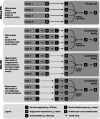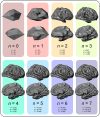Mega-analysis methods in ENIGMA: The experience of the generalized anxiety disorder working group
- PMID: 32596977
- PMCID: PMC8675407
- DOI: 10.1002/hbm.25096
Mega-analysis methods in ENIGMA: The experience of the generalized anxiety disorder working group
Abstract
The ENIGMA group on Generalized Anxiety Disorder (ENIGMA-Anxiety/GAD) is part of a broader effort to investigate anxiety disorders using imaging and genetic data across multiple sites worldwide. The group is actively conducting a mega-analysis of a large number of brain structural scans. In this process, the group was confronted with many methodological challenges related to study planning and implementation, between-country transfer of subject-level data, quality control of a considerable amount of imaging data, and choices related to statistical methods and efficient use of resources. This report summarizes the background information and rationale for the various methodological decisions, as well as the approach taken to implement them. The goal is to document the approach and help guide other research groups working with large brain imaging data sets as they develop their own analytic pipelines for mega-analyses.
Keywords: data sharing; generalized anxiety disorder; mega-analyses; meta-analyses; neuroimaging.
© 2020 The Authors. Human Brain Mapping published by Wiley Periodicals LLC.
Figures




References
-
- Abramian, D. , & Eklund, A. (2019). Refacing: reconstructing anonymized facial features using GANS. IEEE 16th International Symposium on Biomedical Imaging, Venice, Italy, pp. 1104–1108.
-
- Adhikari, B. M. , Jahanshad, N. , Shukla, D. , Turner, J. , Grotegerd, D. , Dannlowski, U. , … Kochunov, P. (2018). A resting state fMRI analysis pipeline for pooling inference across diverse cohorts: An ENIGMA rs‐fMRI protocol. Brain Imaging and Behavior, 13(5), 1453–1467. 10.1007/s11682-018-9941-x - DOI - PMC - PubMed
-
- Alfaro‐Almagro, F. , Jenkinson, M. , Bangerter, N. K. , Andersson, J. L. R. , Griffanti, L. , Douaud, G. , … Smith, S. M. (2018). Image processing and quality control for the first 10,000 brain imaging datasets from UKbiobank. NeuroImage, 166, 400–424. 10.1016/j.neuroimage.2017.10.034 - DOI - PMC - PubMed
-
- Alfino, M. , & Mayes, G. R. (2003). Reconstructing the right to privacy. Social Theory and Practice, 29(1), 1–18. 10.5840/soctheorpract20032915 - DOI
Publication types
MeSH terms
Grants and funding
- ZIA-MH002782/NH/NIH HHS/United States
- Z01 MH002781/ImNIH/Intramural NIH HHS/United States
- R00 HD105002/HD/NICHD NIH HHS/United States
- K23 MH109983/MH/NIMH NIH HHS/United States
- R01 MH122389/MH/NIMH NIH HHS/United States
- T32 MH100019/MH/NIMH NIH HHS/United States
- U54 EB020403/EB/NIBIB NIH HHS/United States
- K99 HD105002/HD/NICHD NIH HHS/United States
- U54-EB020403/NH/NIH HHS/United States
- Z01 MH002782/ImNIH/Intramural NIH HHS/United States
- K23 MH114023/MH/NIMH NIH HHS/United States
- R01 MH116147/MH/NIMH NIH HHS/United States
- R01MH101486/NH/NIH HHS/United States
- K23MH109983/NH/NIH HHS/United States
- ZIA-MH002781/NH/NIH HHS/United States
- T32MH100019/NH/NIH HHS/United States
- R01 MH101486/MH/NIMH NIH HHS/United States

